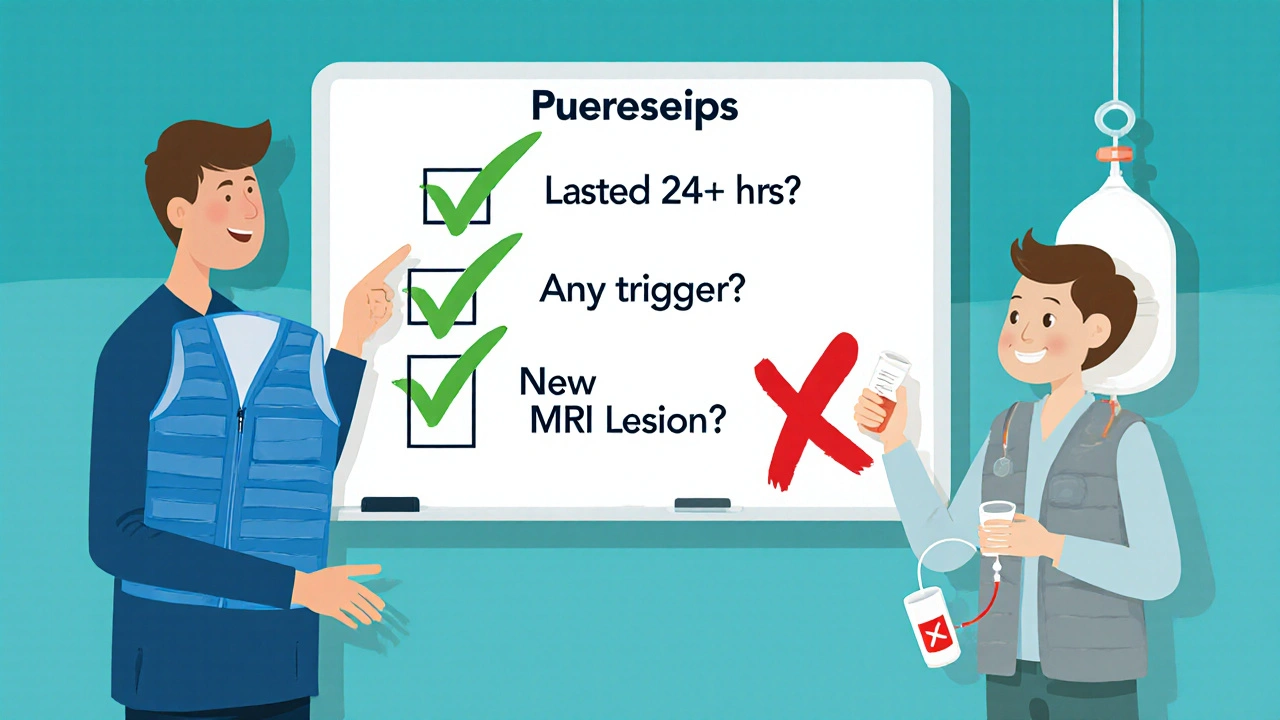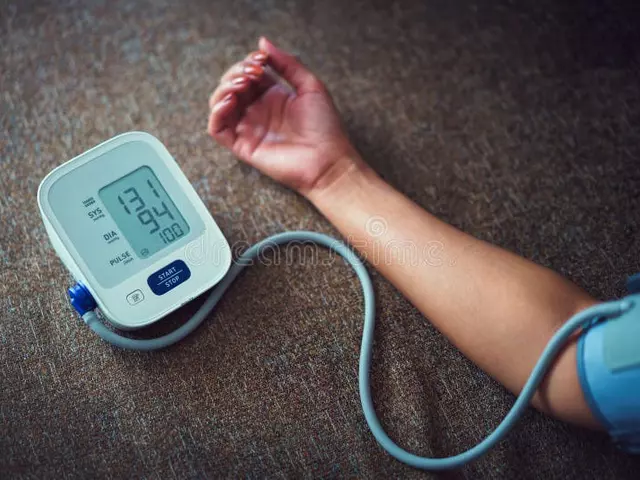
When your MS symptoms suddenly get worse, it’s natural to panic. Is this a relapse? Did the disease suddenly flare up again? Or is it something else-something temporary, something you can fix without drugs? The difference between a true MS relapse and a pseudorelapse isn’t just medical jargon. It’s the difference between getting IV steroids and avoiding them altogether. And getting it wrong can mean unnecessary side effects, higher costs, and even serious complications like steroid-induced psychosis.
What’s Really Happening: Relapse vs. Pseudorelapse
A true MS relapse happens when your immune system attacks your central nervous system again. New inflammation damages the myelin sheath around nerves. That’s what causes new symptoms-or makes old ones much worse. These symptoms last at least 24 to 48 hours, and they’re not tied to anything like a fever or a hot shower. If you’ve had numbness in your leg before, and now it’s spreading to your whole side, and it’s been going on for two days with no obvious reason, that’s likely a relapse. A pseudorelapse is different. It’s not new damage. It’s old damage acting up. Think of it like a frayed wire that works fine until it gets too hot. When your body temperature rises-even by a degree or two-nerves that are already damaged by MS can’t send signals properly. Your symptoms get worse, but your brain and spinal cord aren’t getting hit by new inflammation. Once the trigger is gone, so are the symptoms. This is called Uhthoff’s phenomenon when heat causes vision problems. Around 60 to 80% of people with MS who’ve had optic neuritis experience this.What Triggers a Pseudorelapse?
Pseudorelapses aren’t random. They’re tied to specific, often avoidable, triggers. The most common one? Urinary tract infections (UTIs). In fact, about 67% of pseudorelapses are linked to infections, and UTIs make up the biggest chunk. If you’ve had a sudden spike in bladder issues, fatigue, or leg weakness-and you haven’t had a relapse in months-check for a UTI. A simple urine test can confirm it. Heat is another big one. A hot bath, a sauna, even a hot day outside can trigger symptoms. You might notice your vision blurring, your legs feeling heavy, or your balance getting worse. It’s not the heat causing damage-it’s just making your damaged nerves work even harder. Cooling down, even with a fan or a cooling vest, can reverse the symptoms in minutes to hours. Other triggers include:- Fever from a cold or flu (32% of cases)
- Physical exhaustion or overexertion (28%)
- High stress levels (19%)
- Electrolyte imbalances like low sodium
When Steroids Are-and Aren’t-Used
Steroids like high-dose IV methylprednisolone are the standard treatment for true relapses. They reduce inflammation, speed up recovery, and help you get back to normal faster. About 70 to 80% of people see improvement within days. But steroids don’t fix pseudorelapses. Why? Because there’s no inflammation to fight. Giving steroids for a pseudorelapse doesn’t help. It just adds risk. Around 25% of patients develop high blood sugar. 40% get severe insomnia. 30% feel anxious or depressed. And since steroids weaken your immune system, you’re more likely to get worse infections. One nurse on Reddit shared that five patients she saw in a year got unnecessary IV steroids for UTI-triggered pseudorelapses. One ended up in the hospital with steroid-induced psychosis. The American Academy of Neurology says: Before you treat a relapse, rule out triggers. Check for fever. Test for UTIs. Look at your sodium levels. If you find a trigger, treat that-don’t reach for the steroids. Only if symptoms last more than 48 hours, and no trigger is found, should steroids be considered.
How Doctors Tell the Difference
Neurologists use a simple three-step checklist:- Did symptoms last more than 24 hours?
- Is there a clear trigger (infection, heat, stress)?
- Is there new damage on an MRI?
Who’s Most at Risk for Pseudorelapses?
You’re more likely to have pseudorelapses if you’ve had MS for a long time. As the disease progresses, you accumulate more nerve damage. That means more pathways are vulnerable to heat, fatigue, or infection. Older patients, especially over 55, are also more likely to have lasting functional changes after a pseudorelapse-not because of new damage, but because their bodies take longer to recover from the strain. About 15% of older patients don’t fully bounce back after a heat-triggered episode, even after cooling down. It’s also more common in people with higher disability scores. Someone who already uses a cane might notice their walking gets much worse during a UTI. That doesn’t mean the MS is getting worse. It means their body is already running on empty, and the infection pushed them over the edge.What You Can Do Right Now
You don’t need to wait for a flare-up to be prepared. Here’s what works:- Keep a symptom diary. Note temperature, sleep, stress, infections, and activity levels.
- Know your triggers. If heat makes you worse, avoid hot showers. Use cooling towels or vests in summer.
- Treat UTIs fast. If you have burning, urgency, or cloudy urine, get tested. Don’t wait.
- Don’t assume every symptom spike is a relapse. Ask: Did something change? Did I get sick? Did I overdo it?
- Ask your doctor about the MS-Relapse Assessment Tool (MS-RAT). It’s a new online tool that asks you questions about your symptoms and gives a probability score for relapse vs. pseudorelapse-with 92% accuracy.
The Bigger Picture
Misdiagnosing a pseudorelapse as a relapse isn’t just a mistake-it’s expensive. In the U.S. alone, unnecessary steroid treatments for pseudorelapses cost about $12.7 million a year. That’s money spent on hospital visits, IV drips, and managing side effects that could have been avoided. The good news? Awareness is growing. Telehealth platforms like MS Selfie are helping patients record symptoms and send them to specialists in real time. With better tools and better education, more people are learning to recognize pseudorelapses before they rush to the ER. The key takeaway? Not every worsening of symptoms means your MS is progressing. Sometimes, it’s just your body asking for rest, cool air, or a simple antibiotic. Knowing the difference gives you control. It keeps you from unnecessary treatments. And it helps you live better with MS-without fear of every little change being a disaster.How do I know if my symptoms are a relapse or a pseudorelapse?
Check for triggers first: Did you get sick? Are you overheated? Have you been stressed or exhausted? If yes, and your symptoms improve within hours after fixing the trigger, it’s likely a pseudorelapse. If symptoms last more than 48 hours with no clear cause, and you have new or worsening neurological signs, it’s probably a true relapse. An MRI can confirm new lesions if there’s still doubt.
Can pseudorelapses cause permanent damage?
No. Pseudorelapses don’t cause new nerve damage or lead to long-term disability. They’re temporary disruptions in nerve signaling due to existing damage. But in older or more disabled patients, the strain from a pseudorelapse can lead to temporary loss of function, like needing a walker for a few days after a UTI. That’s not progression-it’s deconditioning. Getting back to normal activity helps restore function.
Why do steroids work for relapses but not pseudorelapses?
Steroids reduce inflammation. True relapses involve active inflammation damaging nerves. Pseudorelapses involve no new inflammation-just existing damaged nerves struggling under stress. Giving steroids for pseudorelapses is like using a fire extinguisher on a power outage. It doesn’t fix the problem and can cause side effects like high blood sugar, insomnia, or mood swings.
What’s Uhthoff’s phenomenon, and how common is it?
Uhthoff’s phenomenon is a type of pseudorelapse where symptoms-usually vision problems-worsen with increased body temperature. It affects 60 to 80% of MS patients who’ve had optic neuritis. Symptoms improve within minutes to hours after cooling down. It’s not dangerous, but it’s a clear sign you’re sensitive to heat. Cooling vests, staying in air-conditioned spaces, and avoiding hot tubs help manage it.
Should I get an MRI every time my symptoms get worse?
No. MRIs are expensive and not always necessary. If your symptoms clearly match a trigger like heat or infection and improve quickly, you likely don’t need one. But if symptoms last over 48 hours, are new, or you’re unsure, an MRI can show whether there’s new inflammation. Your neurologist will decide based on your history and symptoms-not just because you’re worried.
Can stress really trigger a pseudorelapse?
Yes. Stress raises cortisol and body temperature slightly, and it can disrupt sleep and immune function. For someone with MS, that’s enough to overload already damaged nerves. Studies show stress triggers pseudorelapses in about 19% of cases. Managing stress with rest, breathing exercises, or counseling can help prevent these episodes.
Is there a test to confirm a pseudorelapse?
There’s no single blood test, but doctors use a combination: checking for fever, testing urine for infection, measuring sodium levels, and reviewing your symptom diary. The new MS-Relapse Assessment Tool (MS-RAT) uses your answers to questions about duration, triggers, and function to give a probability score. It’s 92% accurate at distinguishing relapses from pseudorelapses.




